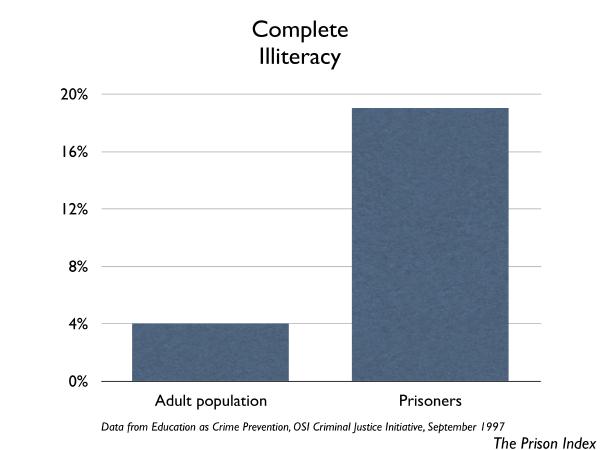Section I: Crime & Punishment in the U.S.
The Roots of Crime?
Guns
- Percent of public who believe the availability of guns is a critical factor in crime138: 40%
- Percent reporting having a gun in their home, 2000139: 42%
- Percent in 2000 supporting making gun laws more strict140: 62%
- Percent in 2000 who would vote to make manufacture, sale or possession of assault rifles illegal141: 59%
- Percent in 2000 supporting making gun laws less strict142: 2%
- Percent of murders and non-negligent manslaughters where a firearm was used, 1964143: 55%
- Percent of murders and non-negligent manslaughters where a firearm was used, 1999144: 65%
Drug and alcohol addiction
- Percent of public who believe the use of drugs is a critical factor in crime145: 59%
- Percent in 2000 who said money and effort to attack social problems would be more effective at reducing crime than more law enforcement146: 68%
- Percent of state prisoners who have been using alcohol at the time of their offense, 1997147: 37%
- Percent of state prisoners who used alcohol at the time of their offense who have received alcohol treatment while in prison148: 14%
- Percent of state prisoners who have been using drugs at the time of their offense, 1997149: 33%
- Percent of state prisoners who used drugs at the time of their offense who have received drug treatment while in prison150: 18%
Education
- Percent of U.S. incarcerated population that is completely illiterate151: 19%
- Percent of U.S. adult population that is completely illiterate152: 4%
- Percent of U.S. incarcerated population that is functionally illiterate, meaning they would be unable to write a letter explaining a billing error153: 40%
- Percent of U.S. adult population that is functionally illiterate154: 21%

- Percent of released New York prisoners under 21 who do not possess a GED that were returned to prison within 3 years155: 54%
- Percent of released New York prisoners under 21 who earned a GED while incarcerated that were returned to prison within 3 years156: 40%
Do prisons cause more crime?
- Year Gideon v. Wainright was decided, giving defendants the right to a court appointed lawyer157: 1963
- As a result of the Gideon decision, number of prisoners in Florida released early because their convictions were unconstitutional158: 1,252
- Percent of a matched control group who were released after completing their sentences who committed a new crime and returned to prison159: 25.4%
- Percent of Gideon group, just like the control group except they spent less time in prison for the same types of offenses and with the same background who returned to prison for the commission of new crimes160: 13.6%
This page is an excerpt from The Prison Index: Taking the Pulse of the Crime Control Industry (April 2003) by Peter Wagner, published by the Western Prison Project and the Prison Policy Initiative.
Footnotes
138 Bureau of Justice Statistics, Sourcebook of Criminal Justice Statistics, 2000, Table 2.42.
139 Bureau of Justice Statistics, Sourcebook of Criminal Justice Statistics, 2000, Table 2.69.
140 Bureau of Justice Statistics, Sourcebook of Criminal Justice Statistics, 2000, Table 2.75.
141 Bureau of Justice Statistics, Sourcebook of Criminal Justice Statistics, 2000, Table 2.81.
142 Bureau of Justice Statistics, Sourcebook of Criminal Justice Statistics, 2000, Table 2.75.
143 Bureau of Justice Statistics, Sourcebook of Criminal Justice Statistics, 2000, Table 3.138.
144 Bureau of Justice Statistics, Sourcebook of Criminal Justice Statistics, 2000, Table 3.138.
145 Bureau of Justice Statistics, Sourcebook of Criminal Justice Statistics, 2000, Table 2.42.
146 Bureau of Justice Statistics, Sourcebook of Criminal Justice Statistics, 2000, Table 2.46.
147 Bureau of Justice Statistics, Substance Abuse and Treatment, State and Federal Prisoners, 1997, p. 1.
148 Bureau of Justice Statistics, Substance Abuse and Treatment, State and Federal Prisoners, 1997, p. 1.
149 Bureau of Justice Statistics, Substance Abuse and Treatment, State and Federal Prisoners, 1997, p. 1.
150 Bureau of Justice Statistics, Substance Abuse and Treatment, State and Federal Prisoners, 1997, p. 1.
151 Education as Crime Prevention, OSI Criminal Justice Initiative. September 1997.
152 Education as Crime Prevention, OSI Criminal Justice Initiative. September 1997.
153 Education as Crime Prevention, OSI Criminal Justice Initiative. September 1997.
154 Education as Crime Preven tion, OSI Criminal Justice Initiative. September 1997.
155 State of New York Department of Correctional Services, Follow-Up Study of a Sample of Offenders Who Earned High School Equivalency Diplomas (GEDs) While Incarcerated in DOCS, May 2001, Figure 1.
156 State of New York Department of Correctional Services, Follow-Up Study of a Sample of Offenders Who Earned High School Equivalency Diplomas (GEDs) While Incarcerated in DOCS, May 2001, Figure 1.
157 Gideon v. Wainright, 372 U.S. 335 (1963).
158 Charles J. Eichman, The Impact of the Gideon Decision Upon Crime and Sentencing in Florida: A Study of Recidivism and Socio-Cultural Change, (1966), p. 3.
159 Charles J. Eichman, The Impact of the Gideon Decision Upon Crime and Sentencing in Florida: A Study of Recidivism and Socio-Cultural Change, (1966), p. 3
160 Charles J. Eichman, The Impact of the Gideon Decision Upon Crime and Sentencing in Florida: A Study of Recidivism and Socio-Cultural Change, (1966), p. 3.
Events
- April 15-17, 2025:
Sarah Staudt, our Director of Policy and Advocacy, will be attending the MacArthur Safety and Justice Challenge Network Meeting from April 15-17 in Chicago. Drop her a line if you’d like to meet up!
Not near you?
Invite us to your city, college or organization.



